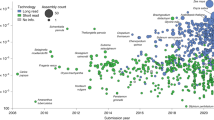
Overview
- This book is open access, which means that you have free and unlimited access
- Examines the history of genomics in a unique way, due to its wide chronological timeframe and multispecies approach
- Critically reinterprets the ‘translational gap’ between sequence data and their potential uses
- Highlights the significance of scientific communities that were eclipsed by the Human Genome Project
Part of the book series: Medicine and Biomedical Sciences in Modern History (MBSMH)
Buy print copy
Tax calculation will be finalised at checkout
About this book
Exploring the use of genomic tools by biochemists, cell biologists, and medical and agriculturally-oriented geneticists, this book portrays the history of genomics as inseparablyentangled with the day-to-day practices and objectives of these communities. The authors also uncover often forgotten actors such as the European Commission, a crucial funder and forger of collaborative networks undertaking genomic projects. In examining historical trajectories across species, communities and projects, the book provides new insights on genomics, its dramatic expansion during the late twentieth-century and its developments in the twenty-first century. Offering the first extensive critical examination of the nature and historicity of reference genomes, this book demonstrates how their affordances and limitations are shaped by the involvement or absence of particular communities in their production.
Similar content being viewed by others
Keywords
Table of contents (8 chapters)
-
Front Matter
-
The Diversity of Genomics
-
Front Matter
-
-
The Diversity of Genomics
-
Communities and Reference Genomes
-
Front Matter
-
-
Communities and Reference Genomes
-
Contextualising and Enhancing Reference Genomes
-
Front Matter
-
-
Contextualising and Enhancing Reference Genomes
-
Back Matter
Reviews
“The history of genomics, García-Sancho and Lowe argue, is more than just the history of the Human Genome Project. Diving deeply into the history of the yeast and pig genomic project next to those of the human, the authors show how multifaceted and varied the field of genomics is. What is regarded as a reference sequence, how it is turned into auseful resource and who participates in the effort changes from species to species. These insights also change our understanding of the Human Genome Project. The book is an important addition to the historiography of genomics.” (Soraya de Chadarevian, University of California, USA)
Authors and Affiliations
About the authors
Miguel García-Sancho is a Senior Lecturer at the University of Edinburgh in the UK. He led the project ‘TRANSGENE: Medical Translation in the History of Modern Genomics’, with funding from the European Research Council.
James Lowe is a Senior Research Fellow at the University of Edinburgh in the UK. He is a historian and philosopher of biology who worked on the European Research Council-funded project ‘TRANSGENE: Medical Translation in the History of Modern Genomics’.
Bibliographic Information
Book Title: A History of Genomics across Species, Communities and Projects
Authors: Miguel García-Sancho, James Lowe
Series Title: Medicine and Biomedical Sciences in Modern History
DOI: https://doi.org/10.1007/978-3-031-06130-1
Publisher: Palgrave Macmillan Cham
eBook Packages: History, History (R0)
Copyright Information: The Editor(s) (if applicable) and The Author(s) 2023
Hardcover ISBN: 978-3-031-06129-5Published: 01 April 2023
Softcover ISBN: 978-3-031-06132-5Published: 01 April 2023
eBook ISBN: 978-3-031-06130-1Published: 31 March 2023
Series ISSN: 2947-9142
Series E-ISSN: 2947-9150
Edition Number: 1
Number of Pages: XVI, 380
Number of Illustrations: 13 b/w illustrations, 13 illustrations in colour
Topics: History of Science, History of Medicine, Modern History, Animal Genetics and Genomics



